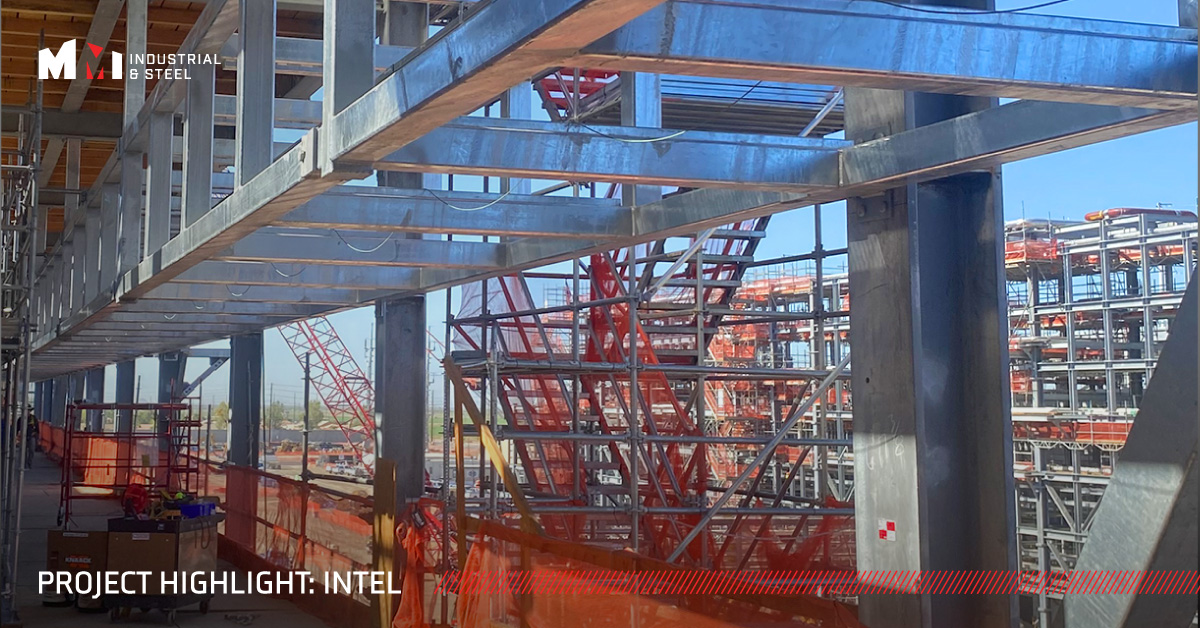
As we enter 2025, the construction sector is poised for dynamic shifts influenced by macroeconomic trends, consumer behavior, and industry-specific factors. For MMI Industrial & Steel, understanding these trends is essential as we work to align strategies and seize emerging opportunities.
Here’s a breakdown of forecasted trends for 2025, and an exploration of their potential implications for MMI as a business. (These trends are based on the June 2024 report by ITR Economics.)
1. The Shift in Nonresidential Construction
The nonresidential construction sector is a key market for MMI Industrial & Steel. However, this market is experiencing slowed growth. While annual activity was up 19.3% in April 2024 compared to the previous year, indicators suggest this momentum is tapering. Factors such as high interest rates and inflationary pressures are having a significant impact on the direction of this trend.
For MMI, this highlights the need to focus on sectors with stable or growing demand. Sectors like high-tech facilities or energy-related infrastructure, for example, continue to see investment despite overall market slowdowns. MMI needs to prioritize projects in these areas in order to remain resilient in the face of fluctuating market conditions.
2. Resurgence of High-Tech Construction
Segments like high-tech manufacturing and renewable energy infrastructure are thriving. In fact, components like semiconductors and communication equipment have experienced double-digit growth. MMI can capitalize on this trend by prioritizing projects for advanced technology facilities, such as data centers or EV battery plants.
Additionally, this trend reflects a movement toward green building solutions and sustainability certifications. This presents an opportunity to innovate and offer more environmentally friendly solutions that are tailored to high-tech applications.
3. Long-Term Inflation and Pricing Challenges
Everyone seems to be experiencing the pressure of inflation, and these pricing challenges will continue to persist in 2025 and even into 2026. Producer prices for finished goods are plateauing at levels significantly above pre-pandemic benchmarks, with further increases expected for at least another year.
For MMI, this presents an opportunity to develop proactive pricing strategies and fine-tune operational efficiencies in order to maintain competitive margins. Investing in energy-efficient processes and leveraging AI-driven tools can help mitigate cost pressures and enhance productivity. Additionally, maintaining relationships with suppliers can help stabilize costs and ensure uninterrupted access to quality materials.
4. Labor Market Pressures
The construction and manufacturing sectors continue to grapple with labor shortages and wage inflation, with construction wages rising 19-22% compared to pre-pandemic levels. This is an ongoing challenge that sheds light on the importance of workforce development and employee retention.
For MMI, addressing this situation involves:
- Enhanced employee training: Specialized programs for existing employees can help increase productivity and job satisfaction.
- Adopting automation: Automated processes help reduce reliance on manual labor.
- Fostering workplace retention initiatives: Creating a culture of engagement and offering competitive benefits will help MMI attract and retain top talent.
5. Infrastructure Investments and Energy Trends
Energy infrastructure, particularly related to oil and gas extraction, remains a bright spot. Although growth is slowing, there is still a robust demand for renewable energy and electrification projects, which will sustain activity throughout 2025.
MMI can position itself as a leading provider of steel solutions for sustainable energy projects, such as wind turbines, solar farms, and electric vehicle charging stations. Building a reputation as experts in the renewable energy space will help strengthen trust between MMI and clients, while also broadening the company’s market reach.
6. Strategic Adaptations for 2025
Mild-to-moderate economic growth is expected during 2025. Companies should assess their labor and operational needs, focusing on goods and services that align with emerging demand.
For MMI, this means:
- Anticipating client needs in key sectors, including high-growth sectors like renewable energy and advanced manufacturing
- Enhancing supply chain resilience (by diversifying suppliers or building inventory buffers, for example)
- Innovating in product offerings to meet the demands of a transforming market
The Road Ahead
A new year always presents new challenges and opportunities, and 2025 will be no different. The forecasted trends for the coming year will give MMI the chance to rethink certain strategies; realign our efforts to better fit client demand; and reevaluate how we do business in an ever-changing world.
As MMI works to navigate this evolving landscape, we can continue to deliver exceptional value to our clients and provide stable, meaningful work for our team members. As we leverage these insights to drive growth and resilience, we can make 2025 one of our best years yet.
Whether you’re ready to break ground on a new project, or you’re navigating a challenging build, MMI is here to support you. Discover how our core values can elevate your next project on our website.



